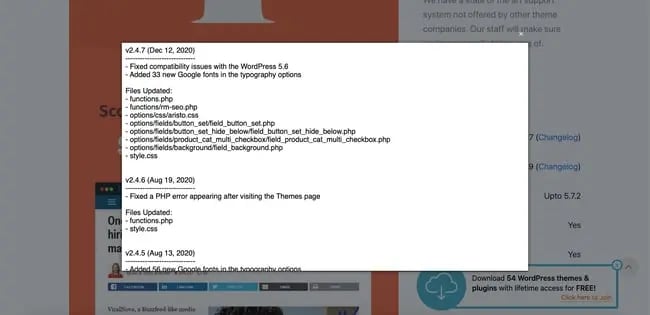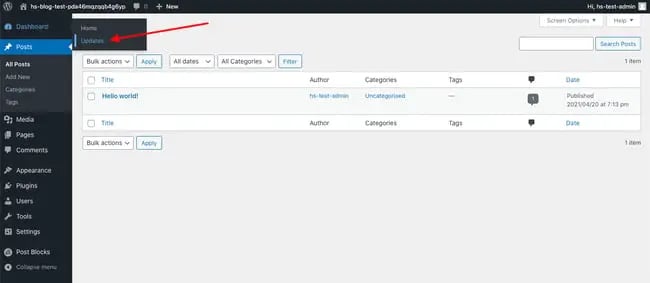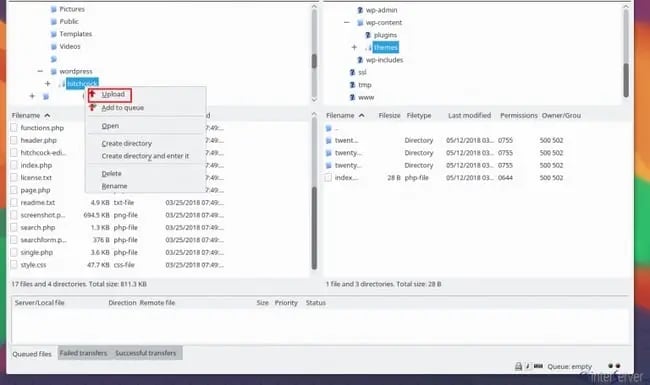WordPress themes let you create a website that looks professional and matches your brand identity. Learning how to update a WordPress theme can be daunting with how important it is for a website. Themes not only impact your site’s design — they impact your site’s speed, performance, SEO, and user experience.

Below, we’ll cover why you need to regularly update your theme, then walk through how to do it.
Table of Contents
- Why Update Your WordPress Theme?
- How to Update Automatically
- How to Update Manually
- How to Update via Ftp
- How to Use a Child Theme to Avoid Losing Customizations
Why Update Your WordPress Theme?
You want to keep every part of your WordPress website up-to-date, from the software to your plugins to your theme. Updating your theme in particular improves the security, functionality, performance, and compatibility of your site. Let’s take a closer look at these reasons below.
Security
One of the best ways to keep your WordPress site secure is by updating your software, plugins, and themes as soon as updates become available. These updates often include the latest security patches to protect against known vulnerabilities and backdoors. Not installing these updates leaves your site vulnerable to known threats as well as unknown threats, which are constantly emerging.
Feature Upgrades
In addition to containing the latest security patches, theme updates typically contain new features and demos. These additional features may have been requested by existing users, or may be in response to new features of the WordPress software. For example, when WordPress released the Gutenberg editor, some theme updates added a block-based theme builder. By installing updates like these, you’ll be able to leverage the full potential of your theme.
Below is OceanWP’s theme page promising more features, extensions, and customization options available in its latest version.

Performance Optimization
Theme updates may contain the latest security patches and features as well as tweaks for performance optimization. Many theme updates, for example, are focused on reducing the weight and HTTP requests of a theme so it loads faster. Installing these updates will ensure your theme is running at its maximum performance.
Here’s a look at a blog post promoting the 3.3 version of the best-selling Astra theme as the fastest version yet.

Compatibility
You also want your theme to be compatible with the latest version of WordPress. Ideally, when a new version of the software is released, theme developers will test their themes against the latest version, make any necessary changes, and release an update.
Installing updates will help you avoid any compatibility issues on your site. Here’s an example of SociallyViral’s changelog noting that the updated theme version has resolved compatibility issues with the 5.6 version of WordPress.

Update a WordPress Theme Automatically
To avoid the security, performance, and compatibility issues related to an outdated theme, you can set up auto-updates. That way you don’t even have to worry about checking when updates are available in your dashboard. Follow the process below to set up auto-updates for your WordPress theme.
Note: you’ll need WordPress 5.5 or later to opt in for automatic updates.
- Log in to your WordPress dashboard.
- Click Appearances > Themes. Click on the theme thumbnail that’s active on your site.
- In the theme modal, click Enable auto-updates right below the author of the theme.

Auto-updates will now run twice per day by default. Using the same toggle link, you can disable auto-updates at any time.
This feature makes it easy for site owners to stay on top of updates. Do note that this update method will overwrite all old theme files installed on your website. Meaning you will lose any changes or customizations you made to your theme.
That’s okay if you don’t plan on adding any custom code to your theme — but if you do, you’ll want to avoid auto-updates for your theme.
Update a WordPress Theme Manually
If you simply installed and activated the theme on your site without making any customizations, then updating it is easy. You have two options.
- Log in to your WordPress dashboard. You should see an alert bubble displayed in your WordPress Admin Menu when a new version of a theme is available.
- Click Dashboard > Updates.

- Scroll to the section labeled “Themes.”

- If your themes are all at their latest versions, then you’ll see the following message: Your themes are all up to date.
- If any active or inactive themes are not at their latest version, then select the theme you want to update and click the Update Themes button.
There's another option for manually updating your WordPress theme in your WordPress dashboard. Let's go over it below.
- Click Appearance > Themes.
- A popup message will appear above your active theme saying something like: “New version available. Update now.”
- Click the hyperlinked text “Update now.”
WordPress will automatically download and unzip the theme package, and replace the old theme files with the new ones.
Since this process will overwrite all the old theme files installed on your website, you will lose any changes or customizations you made. To avoid this loss, you can update your theme FTP client installed on your computer. Let’s walk through that process below.
How To Update A WordPress Theme Via Ftp
- Create a backup of your theme.
- Download the updated version of your theme.
- Re-add the customizations to the updated theme files.
- Upload the updated theme folder to your site.
- Activate the updated theme on your site.
- Test your site.
Short for File Transfer Protocol, FTP allows you to transfer your files from your computer to your WordPress hosting account over a secured connection. Below is the process of updating your WordPress theme via the FTP client FileZilla, which is officially recommended by WordPress.
Note: You can also update your WordPress theme using the file manager provided in your host’s control panel. The most popular file manager is cPanel. The process will be nearly identical but instead of logging into your site via FileZilla. You’ll log in to your hosting account’s cPanel and open File Manager.
Step 1: Create a backup of your theme.
- Log in to your site via FileZilla.
- On the left side of the screen, click the public_html folder.
- Open your wp-content folder.
- Open your themes folder.

- Find the folder labeled with your active theme’s name.
- Rename it, adding “_old” to the end of the file name.
- Download that folder to your computer as a backup.
Step 2: Download the updated version of your theme.
- Visit your theme’s website or its landing page in the WordPress directory.
- Download the latest version to your computer. For example, let’s say you’re downloading the free version of Astra.

- Locate the theme’s zip file and extract the theme.

You will now have the old and new versions of the theme on your computer.
Step 3: Re-add the customizations to the updated theme files.
If you remember what customizations you made to the previous version of your theme, then re-adding them to the updated version is easy. Just copy the code snippets from the outdated theme files and paste them into the new ones.
If you don’t, you can use a file comparison tool to find your custom code snippets. WinMerge is a great option for Windows and KDiff3 for Mac.
Open both your old and new theme folders in whatever file comparison software you choose. It will show these files side-by-side so you can quickly spot the custom code snippets you added to the old theme folder.
Here’s an example of a user comparing an old and newer version of the NewsPaper theme with WinMerge.

Then, you can copy those snippets from the old theme file and past them into the same file in the new theme folder.
Once you’re done, you’ll have the updated version of your theme with your previously-made customizations. Now it’s time to upload it to your site.
Step 4: Upload the updated theme folder to your site.
You should still be logged in to your site via FileZilla from the first step. If not, log back in.
- On the left side of the screen, click the public_html folder.
- Open your wp-content folder.
- Open your themes folder.
- Upload your new theme directory.

Step 5: Activate the updated theme on your site.
- Log in to your WordPress dashboard.
- Click Appearance > Themes.
- You should see two themes with slight variations of the same name: one with your theme’s name and one with your theme’s name plus “_old.” Make sure to activate the new theme.
- You may be prompted to overwrite the theme. In that case, click the Replace current with uploaded button.

Step 6: Test your site.
Now that you have now successfully updated your WordPress theme, go to your website to test that everything is working as expected.
If anything isn’t working as expected or is missing, you might need to revisit your backup of the old theme files and make sure you copied everything across to your new theme files.
Using a Child Theme to Avoid Losing Customizations
If this process seems complicated, then you might be better off creating a child theme. A child theme is a sub-theme that inherits the look, feel, and functions of the parent theme. When you make modifications to the child theme, they are kept separate from the parent theme’s files. That means you’ll be able to update the parent theme without losing your customizations.
For an in-depth look at this option, check out How to Create a WordPress Child Theme: A Step-by-Step Guide.
Keeping Your WordPress Theme Up-to-Date
You work hard to keep your content, images, and software up-to-date — why wouldn’t you keep your theme up-to-date as well? Regularly updating your theme will improve the security, compatibility, and functionality of your WordPress website so you can provide the best experience to your users.
Editor's note: This post was originally published in March 2021 and has been updated for comprehensiveness.







